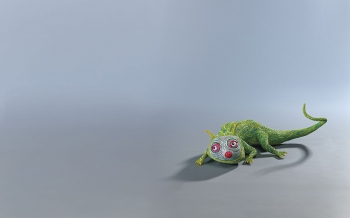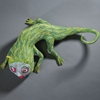Catalogue Note:
Born in Kaohsiung, Taiwan in 1956, Hsu Tzu-kuey's family originally came from the Penghu Islands (also known as the Pescadores, which lie between Taiwan and China in the middle of the Taiwan Strait). The beautiful sunsets at Hsi-yu Island, the rich blue tones of the surrounding ocean, and the texture of the walls of the Penghu Islands' traditional houses – all of which has influenced Hsu's creative work. In 2004, Hsu Tzu-kuey accepted an administrative post as Director of the Department of Fine
Arts at the Tainan University of Technology, which took up a lot of his time and energy. One day, he happened to come across a book about chameleons, and was captivated by their bright colors and ever-changing appearance. He was deeply inspired by this and began to collect large collection of books and articles about chameleons and embarked on the creation of a series of art works relating to chameleons, following his previous "Dragon Transformations," "Ocean Beauty" and "Angel" series.
Through a process of artistic transformation, these images of animals from the natural world become Hsu Tzu-kuey's "mythological family," displaying the wide variety of different forms that life can take. Working from his rich imagination, Hsu is able to give the figures spectacular coloration and lively
expressions. This imaginative exploration of the relationship between nature and the self parallels elements of the primitive art; it takes an animist, polytheistic cosmology as the starting point for imagining how the world is constructed. The "dragon" is transformed into the "soul" in an anthropomorphic manner, with human and animal images being combined to create a sacred spirit. In Hsu Tzu-kuey's "book of myths and fables," he is transformed from the propagator of a "natural world family" into a shaman. At his sacrificial altar, magic spells, and a staff of power, bring forth human desires from the image of a dragon, as the artist takes on the role of metaphoric spirit medium.
The observation of the environment and of life that is reflected in Hsu Tzu-kuey's works does not take the form of abstract, objective, third-party observation; rather, it is first-person, participative observation. Whether in his "Dragon" series, with its reflection of the special characteristics of Hsu's own personal
environment, or in the "Dragon Transformations" series, with its imaginative depictions of desire, for Hsu Tzu-kuey, artistic creation is always a form of self-revelation with respect to life, and the human body. Through this unconscious revelation, Hsu has constructed his own natural world and his own mythology.
Arts at the Tainan University of Technology, which took up a lot of his time and energy. One day, he happened to come across a book about chameleons, and was captivated by their bright colors and ever-changing appearance. He was deeply inspired by this and began to collect large collection of books and articles about chameleons and embarked on the creation of a series of art works relating to chameleons, following his previous "Dragon Transformations," "Ocean Beauty" and "Angel" series.
Through a process of artistic transformation, these images of animals from the natural world become Hsu Tzu-kuey's "mythological family," displaying the wide variety of different forms that life can take. Working from his rich imagination, Hsu is able to give the figures spectacular coloration and lively
expressions. This imaginative exploration of the relationship between nature and the self parallels elements of the primitive art; it takes an animist, polytheistic cosmology as the starting point for imagining how the world is constructed. The "dragon" is transformed into the "soul" in an anthropomorphic manner, with human and animal images being combined to create a sacred spirit. In Hsu Tzu-kuey's "book of myths and fables," he is transformed from the propagator of a "natural world family" into a shaman. At his sacrificial altar, magic spells, and a staff of power, bring forth human desires from the image of a dragon, as the artist takes on the role of metaphoric spirit medium.
The observation of the environment and of life that is reflected in Hsu Tzu-kuey's works does not take the form of abstract, objective, third-party observation; rather, it is first-person, participative observation. Whether in his "Dragon" series, with its reflection of the special characteristics of Hsu's own personal
environment, or in the "Dragon Transformations" series, with its imaginative depictions of desire, for Hsu Tzu-kuey, artistic creation is always a form of self-revelation with respect to life, and the human body. Through this unconscious revelation, Hsu has constructed his own natural world and his own mythology.


